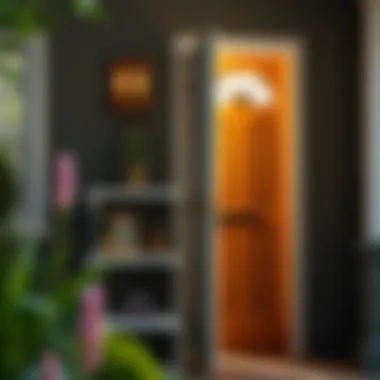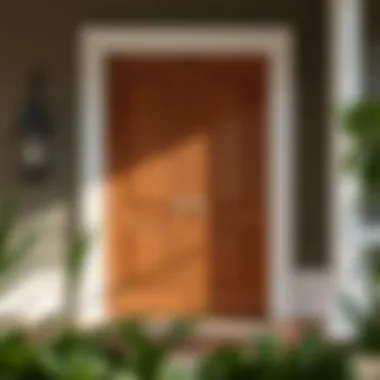Comprehensive Guide to Fixing Drafty Door Sides


Intro
Drafty doors can transform a cozy home into a chilly undertaking. The annoyance of a draft sneaking through your door sides not only disrupts the comfort inside, but it can also lead to increased energy costs and potential security concerns. Homeowners and design enthusiasts alike are often perplexed by how something as seemingly trivial as a door can cause such trouble. By thoroughly understanding the mechanics behind these draughty entrances, you open the door—no pun intended—to numerous solutions that enhance both functionality and style.
In this guide, we will initially focus on identifying signs of air leakage. Once we've diagnosed the problem, we will explore various methods of insulation and sealing techniques that can effectively combat these winds of discontent. Additionally, we’ll touch on necessary materials and tools for effective door maintenance, ensuring we combine practicality with aesthetics.
Consider this a one-stop-shop for crafting a home that sings comfort and energy efficiency while enjoying security—thus elevating your living environment considerably.
Understanding Drafty Door Sides
Understanding drafty door sides is critical for maintaining a comfortable and efficient living environment. Drafts can silently rob your home of heat during winter months and coax it out during summer. This loss goes beyond mere discomfort, leading to inflated energy bills and an unnecessarily high carbon footprint. By exploring the mechanics of door drafts, one can better appreciate how the simple act of sealing your door could transform your home's energy efficiency and comfort levels.
The Importance of Insulation
Insulation acts as the first line of defense against unwanted air flow. It is not just about keeping the outside air where it belongs – it's about maintaining your preferred indoor climate and saving on energy costs. Think of insulation as the sweater you put on during frigid weather; it keeps you warm while minimizing heat loss. When insulation is compromised around door edges, even the most energy-efficient home can become a cold box in the winter. There are various materials to consider, each offering unique benefits. For instance, fiberglass and foam board insulation are not only effective but can also be relatively easy to install for a DIY enthusiast.
Benefits of Good Insulation:
- Reduced Energy Costs: A well-insulated home has lower heating and cooling expenses.
- Enhanced Comfort: Uniform temperature throughout your living space can lead to a much higher quality of life.
- Noise Reduction: Good insulation doesn't just block drafts; it can also muffle outside sounds, providing a more tranquil home environment.
Common Sources of Drafts
Drafts can wander in from various places, but understanding these sources enables effective repairs. Doors itself are often the primary culprit, but it doesn't stop there. Here are some common areas to investigate:
- Door Frames: Over time, frames can become misaligned, allowing for significant air leakage.
- Gaps under the Door: A large gap at the bottom can create a portal for cold air and insects alike.
- Transom Windows: These small windows above a door are often forgotten but can be points of air intrusion if not sealed properly.
As you start to take stock of your home's draftiness, consider purchasing a thermal leak detector, which allows you to pinpoint areas that need attention.
"Identifying where drafts come from is the first step in closing the door on drafts completely."
By familiarizing yourself with these common sources, you empower yourself to take corrective action. Addressing issues can enhance the lifespan of your doors and provide a more sustainable living environment for you and your family.
Identifying Drafty Areas
Recognizing where air leaks occur around doors is essential in tackling the problem of drafty door sides. Identifying these areas effectively lays the groundwork for successful sealing and insulation efforts. Many homeowners may not realize that these drafts can lead to increased energy bills and an uncomfortable living environment. Therefore, taking the time to pinpoint the exact locations of these drafts can save not just money, but also enhance indoor comfort.
Visual Inspection Techniques
One of the simplest yet effective ways to identify drafty areas is through a thorough visual inspection. When examining your door, look for gaps or misalignment in the doorframe. Pay attention to any warping or bowing in the door itself. A quick check for damaged weatherstripping can also reveal potential culprits behind air leaks. Here are some specific aspects to focus on:
- Door Frame: Inspect the edges of the door—if you notice light seeping through, it’s a sure sign of a gap.
- Hinges: Sometimes, loose hinges can create misalignments that can lead to drafts. Check to ensure they are secure.
- Sill Plate: Examine the threshold beneath the door. If it's not seated properly, cold air can easily sneak in.
- Aesthetic Detailing: In older doors, decorative moldings may not have a snug fit, allowing for air gaps.
These visual cues are fundamental in understanding where drafts may be occurring and will guide the application of preventive measures.
Utilizing the Candle Test
The candle test stands as a highly reliable method for spotting drafty areas, especially if the visual inspection didn’t yield clear results. This straightforward technique utilizes flame to detect airflow. Here’s how to perform it:
- Gather Materials: All you need is a lit candle or a small incense stick.
- Close All Doors and Windows: Ensure the area is calm with minimal air movement for the most accurate reading.
- Move the Flame: Slowly move the candle along the edges of the door, particularly close to the frame.
- Watch for Movement: If the flame flickers or bends, this indicates air is passing through, showing a draft.
This method is not only effective but also fun. It can turn a mundane task into an interactive one. Remember to be cautious around open flames and ensure this test is conducted in a safe environment.
"Addressing drafts is not just about comfort; it’s a savvy step towards energy efficiency."
By being diligent in identifying drafty areas, homeowners can take informed steps toward creating a more energy-efficient living space. Whether employing visual inspection techniques or utilizing the candle test, these methods empower you to tackle drafts head-on, leading to improved comfort and lower energy bills.
Preventive Measures for Drafty Doors
Preventing drafts at door sides is not just about comfort, it's a sizable matter of long-term efficiency and cost savings. The cumulative effects of unchecked air leaks can lead to higher heating and cooling bills as well as an uncomfortable living environment. Thus, taking preventive actions is essential in maintaining your home’s comfort while also enhancing its energy efficiency. We must focus on a trifecta of effective measures: selecting energy-efficient doors, employing various weather stripping options, and installing door sweeps that collectively form a bulwark against unwanted drafts. Each of these measures is interconnected yet can stand alone to address specific issues.


Selecting Energy-Efficient Doors
When it comes to choosing doors, energy efficiency carries weight. Not only do energy-efficient doors act as efficient barriers against drafts, but they also encapsulate better insulation. Materials often used include fiberglass and insulated steel, which provide excellent thermal resistance compared to traditional wood doors. The R-value is a crucial factor to consider—higher values indicate better insulating properties.
It’s also worth mentioning that the design of the door can influence its efficiency; doors with multiple panes or those equipped with energy-efficient glass can further reduce thermal transfer.
Consider these factors while door hunting:
- Material Composition: Opt for doors crafted from insulative materials.
- Design Quality: Double-check if the door offers an effective seal when closed.
- Manufacturer Certifications: Seek out Energy Star labels on the doors, which can assure you of their performance.
Weather Stripping Options
Weather stripping can often be the unsung hero when addressing drafts. It's like a snug coat for your doors, providing an additional layer that dramatically helps minimize air infiltration. Different types exist; some of the more popular options include:
- V-strip: An effective choice for sealing the top and sides of doors.
- Foam Tape: Not just easy to install, it provides good insulation.
- Magnetic Strips: They're great for keeping doors tightly closed, especially in versatile spaces.
- Door Sweeps: This leads seamlessly into our next topic and is often used in tandem with weather stripping to create a comprehensive draft-proofing barrier.
Door Sweep Installations
Door sweeps offer an added level of defense against drafts while also blocking out unwanted pests. They’re specifically designed to seal the gap between the floor and the door, ensuring that even the slightest breeze doesn't slip through. Installing a door sweep is both straightforward and highly effective. Most modern models can either be nailed or secured with adhesive. In terms of materials, choose a sweep that complements your door:
- Rubber Sweeps: Ideal for most installations, they provide good sealing while being durable.
- Brush Sweeps: These can fit snugly against uneven floor surfaces, preventing any drafts from sneaking below the door.
Keep in mind that keeping door sweeps and weather stripping well-maintained enhances their lifespan. Remember to check periodically for wear and tear, replacing as necessary to keep your home cozy.
Taking preventive measures not only improves comfort but can also lead to savings on energy bills throughout the year.
In summary, by implementing careful selections of doors, weather stripping, and door sweeps, you can effectively boost your home's resistance against drafts. Ensuring that these measures are set in place speaks volumes not just for comfort, but also for the overall energy efficiency of your residence.
Sealing Techniques for Draft Prevention
Addressing the issue of drafts is not just about increasing comfort in your home. It’s also a matter of enhancing energy efficiency and ensuring that your heating and cooling systems function optimally. The right sealing techniques can effectively eliminate those nagging air leaks that often go unnoticed. When well executed, these methods not only contribute to a cozier environment but also lower energy costs, making your home more sustainable in the long run.
Caulking Gaps and Cracks
One of the most straightforward yet crucial methods for sealing drafts is caulking. This technique involves applying a pliable sealant in gaps and cracks around your doors, windows, and any other ill-fitted areas. Caulk fills the spaces that allow cold drafts to sneak in, which is especially important during the winter months.
The effectiveness of caulking lies in its ability to provide a durable barrier against elements. Here are key points to consider:
- Material Selection: Choose high-quality, weather-resistant caulk that suits your needs. Silicone-based caulks are often recommended due to their flexibility and durability, but acrylic latex caulk can also be a viable option for indoor use.
- Application Process: Before applying, ensure the surface is clean and dry. A well-prepared surface guarantees better adhesion. Use a caulking gun for controlled application, and smooth with your fingertip or a tool for a neat finish.
- Inspection After Application: After the caulk has dried, check for any missed spots. A thorough inspection can save you headaches later. If you feel drafts still, a reapplication might be in order.
"Good sealing can turn a drafty door into a noteworthy barrier against the elements." - Home Improvement Expert
Using Foam Insulation
Foam insulation serves as another effective measure to combat drafts, particularly in larger gaps around door frames or in situations where traditional caulking may not be sufficient. Foam insulation can fill voids that regular caulk cannot handle, acting as a cushion against external air.
Here’s why you should consider foam insulation for your drafty doors:
- Versatility: Foam insulation can expand to fill irregularly shaped gaps, which is often the case around old or improperly installed doors. Once applied, it solidifies and creates a tight seal.
- Energy Efficiency: Like caulk, foam insulation significantly improves a home’s energy efficiency. By blocking unwanted airflow, it ensures that your heating system runs less frequently, which translates to savings on utility bills.
- Ease of Use: Foam insulation is relatively easy to apply. Most come in aerosol cans that make it quite convenient to direct exactly where it’s needed. Just be careful not to overapply, as it can expand more than expected.
For installation, follow the product’s instructions closely. Some products require moisture for activation, while others need to be applied dry. This is crucial to achieve optimal results without any unwanted mess.
By implementing these sealing techniques, homeowners can see a marked difference in their home environment. A few hours spent addressing these drafts could lead to a more comfortable and energy-efficient living space.
Materials for Door Sealing
Selecting appropriate materials for sealing doors forms the foundation for effectively addressing draft issues. Quality sealing materials not only contribute to energy efficiency but also enhance the overall comfort of your living space. As such, homeowners must understand the characteristics, benefits, and limitations of these materials before making a choice.
Benefits of Silicone Sealants
Silicone sealants are a popular choice among homeowners for a variety of reasons. Their elasticity enables them to expand and contract with environmental changes, creating a reliable barrier against air infiltration. Moreover, silicone is water-resistant, making it well-suited for external applications.
- Durability: Silicone sealants can last up to 20 years without showing significant wear, reducing the frequency of repairs.
- Versatility: They can be applied to a range of materials, including wood, metal, and glass, making them adaptable to various door types.
- Adhesive Strength: Unlike some other materials, silicone adheres firmly to surfaces, ensuring a long-lasting seal.


While silicone sealants are incredibly effective, they do require proper application. Surfaces need to be clean and dry to ensure optimal adhesion. If not, even the best sealant may not perform well over time.
Comparative Analysis of Weather Strips
Weather stripping is another vital component in the quest to eliminate drafts the right choice can make all the difference. There are several types of weather strips available, each possessing distinct attributes.
- V-Seal (or V-Strip): Simple yet effective, V-Seals can fit into narrow gaps. They create a solid barrier when compressed against the door frame.
- Foam Weather Strips: Easy to install and often self-adhesive, foam strips may not hold up as well under heavy wear. But they provide a great initial fit and can be cost-effective.
- Magnetic Weather Strips: Perfect for metal doors, these strips utilize magnets for a tight seal. However, they tend to be a bit pricier than traditional options.
- Door Sweeps: Though not technically a weather stripping material, door sweeps should not be overlooked. They offer a robust solution for the bottom edge of the door, preventing drafts from seeping underneath.
When weighing your options, consider both initial costs and long-term durability. Lower-cost materials may seem appealing, but investing in high-quality weather stripping can lead to better energy savings in the long run.
"Be mindful of your choices; the smallest gaps can let in a whole lot of cold air!"
Overall, selecting the right materials for door sealing is a critical step in maintaining a comfortable and energy-efficient home. Proper sealants and weather stripping not only serve their purpose in preventing drafts but also significantly contribute to the longevity of your doors.
Aesthetic Considerations in Draft Management
In tackling the issue of drafty door sides, it's easy to get tangled up in the nitty-gritty of sealing techniques and insulation materials. However, the aesthetic aspects of your solutions should not be overlooked. The way your doors look impacts not just the visual appeal of your home but also how well the improvements integrate with the existing design. Consider that your door is often the first thing guests see, and it should exude both warmth and style while effectively keeping chilly drafts at bay.
Blending Functionality with Style
Finding that sweet spot between functionality and style can sometimes feel like looking for a needle in a haystack, but it’s entirely doable. When you think about aesthetics in relation to draft management, consider options like stylish weather stripping that can be found in a range of colors and materials, allowing you to match or even contrast with your door’s finish. Using something that looks nice and does its job well elevates the overall appearance without sacrificing effectiveness.
Imagine a traditional wooden door decked out in a sleek, metallic draft guard; not only does it serve a purpose, but it also adds a contemporary twist to a classic look. It's all about making choices that not only solve the problem at hand but also enhance design coherence.
- Use weather stripping that matches your door color to blend seamlessly.
- Choose attractive door sweeps that complement your home's architecture.
- Opt for decorative caulking options for an added flair.
Designing with Door Hardware
The little details, like door handles and hinges, can significantly influence both functionality and beauty. It’s often said that the devil is in the details, and in design, that couldn’t be more true. Selecting door hardware that aligns with your home's style ensures a more profound aesthetic appeal. Those knobs and handles come in various materials and styles—brushed nickel, bronze, and even ceramic finishes can strike the right chord depending on whether your home leans towards the modern or the rustic side.
Additionally, don’t underestimate the role of decorative hinges in making your door an eye-catching feature. They might seem trivial, yet intriguing hardware can draw the eye and serve as a subtle conversation starter.
Long-Term Maintenance for Exterior Doors
Long-term maintenance for exterior doors is nothing short of essential. While most homeowners might think about immediate fixes when a door becomes drafty, keeping a keen eye on ongoing maintenance can save you significant headaches (and costs) down the road. Not only does it enhance energy efficiency, but it also boosts your home's overall aesthetic. A door that's well maintained speaks volumes about the homeowner's care and attention.
Proper long-term upkeep involves a combination of vigilance, timely interventions, and a bit of elbow grease. Over time, doors can warp, seals can degrade, and hardware can rust. Each of these issues can create or exacerbate drafts, leading to those annoying chills sweeping through your living spaces. Regular maintenance not only keeps these frustrations at bay but also helps with your energy bills, ensuring you remain warm in winter and cool in summer.
Routine Inspections
Regular inspections should become a habit. Once every season, perhaps as you change your clock for daylight savings, take a moment to evaluate your exterior doors. This kind of proactive approach means you catch small problems before they snowball into larger issues.
During these inspections, look for:
- Gaps and Cracks: Check around the door frame for any visible gaps that might let air in or out.
- Seal Condition: Inspect weather stripping and caulking for wear or detachment. If it’s cracked or missing, a replacement is needed.
- Hinges and Handles: Ensure all hardware operates smoothly without rust or fraying. Tighten screws as necessary to maintain structural integrity.
A keen eye can reveal problems that are not immediately obvious. Even something as simple as a slight misalignment can lead to drafts, so be thorough. You might even find it helpful to bring along a notepad to jot down minor issues you can handle later on. After all, an ounce of prevention goes a long way.
Timely Repairs and Replacements
When repairs are needed, it’s vital to address them promptly. Ignoring issues is like putting off fixing a leaky roof – it’ll likely compound into an even bigger issue. For instance, if you encounter gaps in your door’s frame, putting it off can lead to increased energy bills and a less comfortable home.
Here’s how to think about repairs:
- Caulk or Sealant: If you find cracks or missing sealant, promptly apply new caulk or sealant. Not only is the process easy, but it’s also cost-effective.
- Replacing Weather Stripping: If it’s worn out but still holding its shape, you might simply need to reinstall or reposition it. If it’s too stiff or broken, swapping it out for a newer material can make a world of difference.
- Hardware Upgrades: simple replacements for handles or hinges can increase energy efficiency significantly. Consider investing in solid materials that fight rust and wear over time.
In summary, conduct seasonal checks and make timely repairs to your exterior doors. This not only ensures your home stays cozy but protects your investment in the long term. With diligence, you’ll see a noticeable difference in your home’s energy efficiency and appearance.
"An ounce of prevention is worth a pound of cure."


Remember to keep records of your inspections and repairs. This would help you gauge when to call in the pros for significant issues that may arise. For more detailed knowledge on home maintenance, consider visiting resources like Wikipedia or explore discussions at Reddit.
Stay attentive to your exterior doors, and they’ll reward you with comfort and savings for years to come.
Cost Considerations for Insulating Doors
When it comes to maintaining a comfortable home environment, insulating your doors can make a world of difference. However, figuring out the associated costs can be a daunting task. In this section, we will explore the financial aspects you should consider when addressing drafty doors. Understanding the expenses involved isn't just about the upfront costs but also about how those costs tie into broader savings over time.
Budgeting for Upgrades
Before diving into the nitty-gritty of insulating your doors, it’s wise to set a budget. Creating a budget allows homeowners to pinpoint exactly how much they’re willing to invest in various upgrade options. Here are some important aspects to think about while budgeting:
- Material Selection: Different materials come with different price tags. For example, fiberglass doors are generally more expensive than standard wooden doors but provide better insulation. Learn the pros and cons to see if the investment is justified.
- Installation Costs: If you're not a DIY enthusiast, hiring professionals to install weather stripping or new doors can add to your overall expenditure. Always factor in labor costs when budgeting.
- Potential Hidden Costs: Sometimes, underlying issues like warped door frames or inadequate frame support can make a straightforward installation turn tricky. Be ready for possible additional expenses.
An average homeowner might find that setting aside around $500 to $1,000 can cover the cost of upgrading to energy-efficient doors or addressing sealing issues, depending on their choices and the requirements of their specific home.
Value Assessment of Energy Savings
Once you’ve navigated the intricacies of budgeting, it's crucial to evaluate how these investments manifest in energy savings down the line. Insulating doors not only enhances comfort but can also lead to significant financial benefits over time. Here's how:
- Lower Energy Bills: Properly insulated doors can keep your home warmer in the winter and cooler in the summer. Lower energy consumption directly translates to reduced monthly energy bills. The savings could be noticeable starting with your next utility bill.
- Return on Investment (ROI): Energy-efficient improvements generally yield positive ROI. While it may take some time to recoup your initial costs, studies suggest that homeowners can expect a return of approximately 70% to 80% on these kinds of improvements.
- Increased Home Value: Not only do insulated doors improve living conditions, but they can also boost the market value of your property. Future buyers are likely to admire the energy-efficient features and may be willing to pay a premium for them.
To illustrate, the Environmental Protection Agency (EPA) reports that homeowners can save anywhere from 10% to 30% on heating and cooling costs annually when they properly insulate their doors.
Investing in insulated doors is akin to pouring dollars into your home's budget-friendly savings account. It's not just a cost; it's an income generator in terms of energy efficiency.
Expert Recommendations and Resources
Addressing drafty door sides requires more than just quick fixes and DIY attempts. Engaging experts and utilizing invaluable resources can make a world of difference. This section elucidates the importance of expert recommendations and highlights resources available for effective draft management. Consulting professionals and leveraging online tools can provide homeowners with tailored solutions that ensure a more comprehensive approach to insulation and sealing.
Consulting Professionals
Bringing in an expert for door insulation issues could indeed be a game-changer. Professionals often have a wealth of knowledge accumulated through years of experience. They can assess your particular situation, recommending solutions that are not just effective but also align with your home’s unique characteristics. Here are some key benefits of getting professional help:
- In-Depth Assessments: Experts can conduct thorough inspections, identifying hidden flaws that might not be visible to the untrained eye.
- Tailored Solutions: A specialist can offer targeted recommendations based on the specific type of door, its material, and its environment. For instance, a wooden door may require different treatment compared to a steel one.
- Long-Term Investment: Hiring a professional ensures that you’re not throwing money at temporary fixes. Instead, they can provide remedies that enhance the door's longevity and functionality.
- Access to Quality Materials: Professionals typically have access to high-grade materials and products, potentially leading to enhanced results compared to generic options available in stores.
In cities like New York or San Francisco, finding certified insulation specialists can be crucial. Check reputable sites like Angie's List or HomeAdvisor to connect with qualified individuals in your area.
Utilizing Online Tools for DIY Projects
For the more hands-on homeowner, a myriad of online tools can provide step-by-step guidance on addressing drafty door sides. The boom in DIY culture has given rise to platforms filled with tutorials, product comparisons, and user experiences. Here are some valuable resources:
- YouTube Tutorials: Channels dedicated to home improvement often showcase detailed methods for draft sealing, from installing weather stripping to using caulk effectively. This visual guidance can help you grasp the techniques better.
- DIY Blogs: Websites like The Family Handyman or personal blogs often contain personal anecdotes coupled with practical advice, helping you learn from others' successes and failures.
- Apps for Tracking Energy Usage: Utilizing apps that monitor your energy consumption can also inform you about areas where drafts are most problematic. This kind of feedback is crucial for assessing improvements post-repair.
- Online Forums: Platforms such as Reddit can provide community support. By posting your problems or solutions you’ve found, you could gain insights from fellow homeowners or experts who have tackled similar issues.
"Investing time in research and community support can save both energy and money in the long run."
Adopting these expert-driven strategies and employing helpful online tools can empower homeowners to combat drafty door sides effectively, leading to a comfortable living environment and potential energy savings.
Epilogue
In wrapping up the topic of drafty door sides, it's evident that making aware the importance of insulation cannot be overstated. Homeowners often underestimate how much air leaks around doors can affect their comfort and energy consumption. Every little crack and crevice can contribute to an inconsistent indoor climate, which translates to increased heating or cooling costs. Addressing these issues not only promotes comfort but also enhances energy efficiency. It’s like trying to fill a leaky bucket with water; no matter how much water you pour in, the leak means the bucket will remain half-empty.
Summarizing Key Insights
Throughout this guide, we covered various facets of dealing with drafty doors:
- Identifying Drafty Areas: Techniques like the candle test help spot air leaks.
- Preventive Measures: Choosing energy-efficient doors and the right weather stripping can mitigate drafts effectively.
- Sealing Techniques: Proper caulking and the use of foam insulation are essential steps.
- Materials for Door Sealing: Silicone sealants and weather strips each have unique benefits.
- Design Considerations: Aesthetics shouldn’t be overlooked when sealing areas to manage drafts.
- Long-Term Maintenance: Regular inspections and timely repairs ensure doors remain effective barriers against drafts.
- Cost Considerations: Budgeting wisely for improvements can yield significant energy savings over time.
By following these steps, homeowners can create a more efficient and comfortable living environment, stretching their dollars further while creating a warm and inviting home.
Future Considerations in Draft Management
Looking ahead, homeowners should keep in mind that maintaining draft-free doors is not a one-and-done task. Environments change, and so should your approach to energy efficiency:
- Evolving Technologies: Keep an eye on new insulation materials and technologies that might emerge.
- Seasonal Checks: Regularly assess your doors, especially before winter and summer months to address any new drafts that may appear.
- Education and Resources: Engage with online tools and local resources that provide information on how to improve home insulation practices. Websites like Energy.gov offer guidance on efficient energy practices and innovations.
- Professional Advice: Don't shy away from consulting experts to get tailored solutions for your home, considering unique architectural designs that may require creative approaches.
By embracing these future considerations, homeowners can not only tackle current drafts but also shield themselves against potential issues down the line. A proactive mindset toward draft management means a comfortable and energy-efficient home for years to come.



